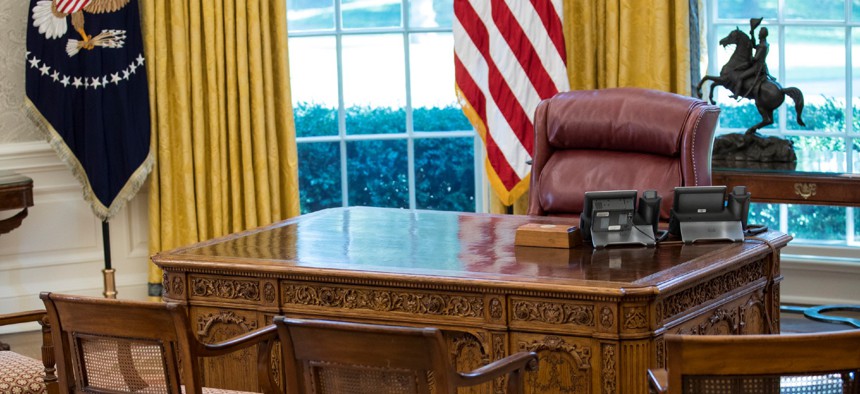
Carolyn Kaster/AP
Biden Should Act Like ‘CEO’ of Federal Workforce, Experts Suggest
Members of a working group at the National Academy of Public Administration said merely rolling back President Trump’s workforce policies will not be enough to empower federal employees—they will need active support from the top.
Members of a working group of federal personnel policy experts said Thursday that in order for President-elect Biden to be successful at rejuvenating the federal workforce, he will need to take an active role as “CEO” of the government.
“I would urge him to take responsibility and personal accountability for leading the federal workforce as though he were the chief executive officer of some large company,” said Robert Tobias, distinguished practitioner in residence at American University’s Key Leadership Program. “He should see himself as if he were evaluated quarterly on whether the executive branch of the government was actually being more efficient and effective.”
Fellows at the National Academy of Public Administration held a panel discussion Thursday on workforce issues facing the Biden administration when it takes office in January. The panelists proposed an executive order last week that would undo much of President Trump’s key civil service policy initiatives, as well as “reinvigorate” the workforce by elevating the Office of Personnel Management to a Cabinet-level agency, devote more resources to training and skills development, and simplify the hiring process.
Experts agreed that simply rolling back the Trump administration’s attacks on the federal workforce, like his executive orders making it easier to fire federal workers and hamstring federal unions, creating a new Schedule F in the excepted service to make “policy-making” workers effectively at-will employees, and banning many types of diversity and inclusion training, will not be enough to equip federal employees to face the nation’s challenges.
“There also need to be some changes in job classifications, pay and hiring,” said Jeff Neal, a former Homeland Security Department chief human capital officer. “Those things can all be done with executive action. [The Biden administration] should maximize agencies’ authority to set pay and provide recruitment, retention and relocation bonuses, expand the use of streamlined hiring authorities in a merit-based way, and cut back on the number of job classification series.”
Doris Hausser, who served as a policy adviser at OPM during the George W. Bush administration, said Trump’s efforts to streamline the federal firing process largely have failed to address the difficulty federal managers have when dealing with poor performers, instead opting for a more “vindictive” approach.
“Is [the Schedule F executive order] potentially useful in dealing with poor performers?” she said. “Potentially, but I know there have been years’ worth of lamentations that managers already have the authority to do it, and they simply don’t manage the use of it. I remember an OPM staffer once told me that if they could install a button on a manager’s desk where the person sitting across the desk would simply be vaporized, and there would be no record that person ever existed, they still wouldn’t push that button. People just aren’t going to treat other people that way.”
The working group’s proposed executive order also calls for the restoration of labor-management partnerships that were established during the Clinton and Obama administrations, but rescinded during the Bush and Trump years. The group stressed, however, that Biden should direct agencies to participate fully in those forums and councils if they hope to succeed—and survive the next Republican administration.
“Fundamentally, this approach will be successful or unsuccessful based on whether the president says, ‘I want you to collaborate, I want you to include and involve employees,’” Tobias said. “[My] fantasy is that labor-management forums would prove their value if their success were measured so that all would want to do it because it makes sense to do it, as opposed to relying on some ideological perspective that unions are bad. If this approach could be proven successful, I think the demand for their continuation would survive from one administration to another.”
Neal said he knows from personal experience that labor-management partnerships can be successful, but only if agencies approach their obligations willingly and in good faith.
“When I was at the Defense Logistics Agency, we had a toxic relationship with the union there, and it was in large part because both sides just wanted to get into a room and yell at one another,” he said. “I was even told that the agency’s preferred way of engaging is what I call unconstructive engagement—that is, get in a room and never agree to anything—and that was by design. We changed that, we spent two or three years trying to work with union officials who were very uncooperative. Eventually, it was so apparent to people in the workforce and some in the union that the agency wanted to work cooperatively that they voted out the horse’s rear ends and put in people who actually wanted to work together and then we built a very effective partnership.”







